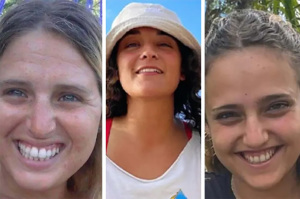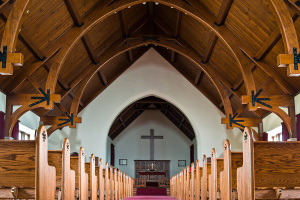Violence at the Holy Land
BETHLEHEM, West Bank - As Holy Wars continue to be waged across the West Bank, scholars look back at the roots of the conflict. Religious, national, and political, the histories of the nations fighting for their sanctuaries remain stained with blood, violence and hatred.
The most recent clash between the Jews and the Palestinians left 12 Israeli solders and securities dead. This explosion erupted in Hebron five weeks ago in an ambush near the Tomb of Patriarchs. Analysts fear similar outbreaks of violence may spark over Rachel's Tomb, a tiny stone building at the entrance of Bethlehem that is revered as the burial site of one of the Bible's greatest women.
The tomb of this woman, mother of Joseph and wife of Jacob, underwent several architectural changes throughout its history. Crusaders built part of the structure 1,000 years ago, the Ottomans made additions 600 years later, a British philanthropist complemented the tomb in 1841, and lastly, under the Israeli army, the venerated structure received the addition of a 12 foot high cement wall, two guard towers, a maze of concrete barriers and a thicket of barbed wire, designed to protect Jewish visitors from Palestinian sharpshooters and stone throwers.
"It's taken a lot away from the beauty of the place, but for the peace and safety of the people who come here, it's very important," said the tomb's caretaker, Yitzhak Maoz.
The site, analyst say, along with the other religious shrines in the holy land, become the focal points of violence because they are vital to the identities to the Jews and the Muslims.
"The battle over the tombs is a kind of microcosm of the conflict. The battle for the tombs is the battle for the land," said Daniel Rossing, a former official in Israel's Ministry of Religious Affairs. "Whose ancestors are they -- mine or the Palestinians? Who owns Abraham? If I control the answer, I have the upper hand."
Asher Cohen, a political scientist at Bar-Ilan University outside Tel Aviv, said the tombs and shrines attract violence "not only because of religious issues, but national issue[s] as well. You can't separate them because all the history of the Jewish nation is religious history, and the same is true for Palestinians."
Many believe the sites to be threats of national security. Since the sites are guarded by Israeli soldiers and visited principally by Jewish settlers, Palestinians view the wars the Israelis' method of expanding their territory.
"The strategy of settlers is to use every small place with some religious connection as an excuse to expand the settlement project," said George Giacamen, a political scientist and director of Muwatin, the Palestinian Institute for the Study of Democracy in Ramallah. "It's not a question of prayer rights for Jews. The issue is using holy sites as a ruse to expand settlements."
After the killings in Hebron on Nov. 15, settlers created a makeshift outpost in the heart of the Palestinian neighborhood where the attack occurred. Israeli soldiers evicted the settlers and dismantled the outpost last week, saying it was illegal.
However, Michael Freund, an editorial writer and columnist at the Jerusalem Post who has studied the history of Jewish tombs, defended the Jews remarking that while different people have different agendas, Jews are most interested in the sites for their religious and historic significance.
"These are the tombs of the founding fathers of the Jewish people, not just from 200 years ago, but over three millennia," he said. "They are a finite symbol of our ties to the land as Jews. This is the land where our ancestors were born and buried, and these tombs demonstrate that more than anything."
Many of the tombs and shrines were off-limits to Jews before Israel captured the West Bank from Jordan in the 1967 Middle East war. Then the tables turned as the Jews converted some of the mosques to synagogues.
The location of Rachel's Tomb, which Jews consider one of their holiest sites, adds an additional layer of religious significance to Bethlehem, believed to be the birthplace of Jesus. But it has also helped draw Israeli soldiers and conflict into city, where the central area is occupied this Christmas season for the first time since Israeli troops withdrew from the city in November 1995 in accordance with the Oslo peace agreements two years earlier.
Such was the case with Joseph's Tomb in Nablus, about 30 miles north of Jerusalem. Once a mosque, it was made into a synagogue and yeshiva in the 1980s under Israeli occupation. Muslims and Jews used it jointly for a brief time in the mid-1990s in the spirit of amity fostered by the Oslo agreements of 1993. However, after Jews were killed there, it was restored to Israeli control in 1996 and guarded as a Jewish pilgrimage site, much as Rachel's Tomb is today. In October 2000, Israeli soldiers withdrew from the site and Palestinians sacked the tomb, torched it and tore it down. Yasser Arafat's Palestinian Authority has since rebuilt it.
"Joseph's Tomb was a place where Jews could come and visit, but then they turned it into a synagogue. This is an attack on our holy sites," said Adnan Husseini, the director of the Islamic trust that oversees Muslim holy places. "This does not contribute to peace and coexistence, but brings about hatred."
It was in Jerusalem, at a bitterly contested site revered by Jews as the Temple Mount and by Muslims as the Noble Sanctuary, that the current uprising began in September 2000. Riots began after Prime Minister Ariel Sharon, then the Israeli opposition leader, took a heavily guarded stroll through the complex.
Last month's attack in Hebron occurred in a Palestinian neighborhood along a path that Jewish settlers use to walk from their homes to the Tomb of the Patriarchs, another shrine shared by Jews and Muslims. Both revere it as the place where the biblical figures Abraham, Sarah, Isaac, Rebecca, Jacob and Leah are buried.
In Bethlehem, Rachel's Tomb -- which is also adored by Muslims and Christians -- has been sealed inside a heavily fortified building. The tomb is no longer visible from the outside, and Palestinians are not allowed access. Foreign tourists can visit, but only Jews are allowed to pray. Most visitors come in armored buses that drop them just a few feet from the front door.
The tomb, which is bordered on three sides by a Muslim cemetery, lies along the road to Jerusalem about 500 yards from the municipal boundaries, as expanded after 1967. The road has been barricaded, effectively severing the main route between Bethlehem -- site of the Church of the Nativity, which according to Christian tradition rests on Jesus's birthplace -- and Jerusalem, where the Church of the Holy Sepulcher marks the place where Christian tradition says Jesus was crucified, buried and resurrected.
"Today, the main significance for Christians is that their institutions in Jerusalem and Bethlehem are so linked that any separation between them is a terrible blow," said Rossing. "Apart from the spiritual and theological significance, Bethlehem is part and parcel of Western culture. Whether it's peaceful or not, it has an image through Christmas carols -- particularly 'Silent Night' and the 'Little Town of Bethlehem' -- that is associated with the joy of birth, and these precious images have been shattered by all the military presence and terrorism.''
Hanna J. Nasser, Bethlehem's mayor, said the level of security around Rachel's Tomb is "unjustified and baseless." The Israeli military presence, he said, provokes Palestinian violence.
"Some Israelis are trying to find excuses to build walls around Rachel's Tomb and spoil the entrance of Bethlehem as a tourist city and cause damage to the people who live and work around there," he said, noting Israeli proposals to erect walls along the streets to create a security corridor for the passage of Jewish visitors. "They should lift this wall surrounding the tomb, get the military out and open the road. Not a single thing would happen."
By Paulina C.





























